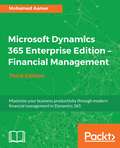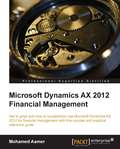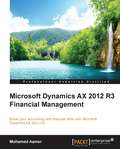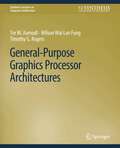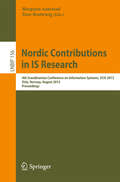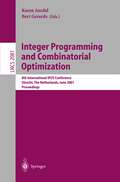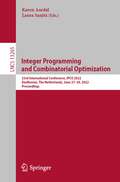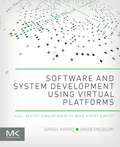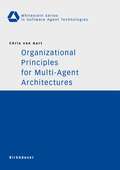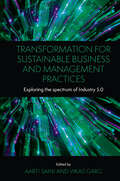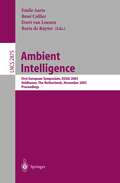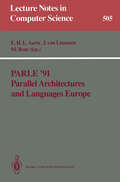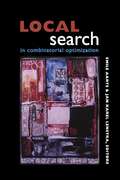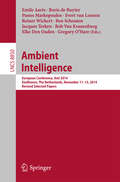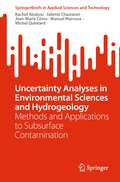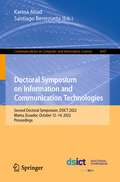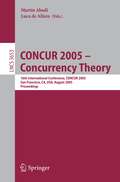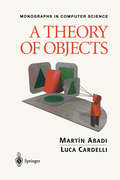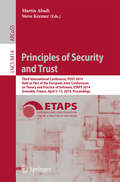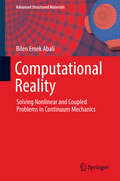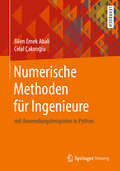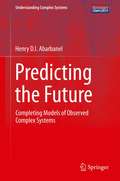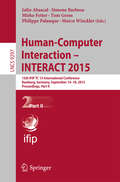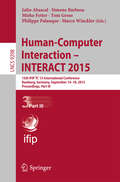- Table View
- List View
Microsoft Dynamics 365 Enterprise Edition – Financial Management - Third Edition: Maximize Your Business Productivity Through Modern Financial Management In Dynamics 365, 3rd Edition
by Mohamed AamerMicrosoft Dynamics 365 for finance and operations is a rapidly growing application and is widely used in enterprise organizations. Because of its ability to maximize business productivity, it is a fast-growing business application package in the ERP market.
Microsoft Dynamics AX 2012 Financial Management
by Mohamed AamerThis book is a practical, hands-on guide that covers both the basic and advanced concepts of financial management using Microsoft Dynamics AX.Microsoft Dynamics AX Financial Management is for Microsoft Dynamics AX solution architects, application consultants, support engineers, pre-technical sales consultants, and project managers on the partner side, as well as chief financial officers, financial controllers, accounting managers, key users, business analysts, and chief information officers on the customer side. A basic knowledge of financial terms, concepts, and Microsoft Dynamics AX terminologies will help you better understand the concepts covered in this book.
Microsoft Dynamics AX 2012 R3 Financial Management
by Mohamed AamerThis book is intended for application consultants, controllers, CFOs, and other professionals who are engaged in a Microsoft Dynamics AX implementation project. Basic knowledge of financial terms, concepts, and Microsoft Dynamics AX terminologies is required.
General-Purpose Graphics Processor Architectures (Synthesis Lectures on Computer Architecture)
by Tor M. Aamodt Wilson Wai Fung Timothy G. RogersOriginally developed to support video games, graphics processor units (GPUs) are now increasingly used for general-purpose (non-graphics) applications ranging from machine learning to mining of cryptographic currencies. GPUs can achieve improved performance and efficiency versus central processing units (CPUs) by dedicating a larger fraction of hardware resources to computation. In addition, their general-purpose programmability makes contemporary GPUs appealing to software developers in comparison to domain-specific accelerators. This book provides an introduction to those interested in studying the architecture of GPUs that support general-purpose computing. It collects together information currently only found among a wide range of disparate sources. The authors led development of the GPGPU-Sim simulator widely used in academic research on GPU architectures. The first chapter of this book describes the basic hardware structure of GPUs and provides a brief overview of their history. Chapter 2 provides a summary of GPU programming models relevant to the rest of the book. Chapter 3 explores the architecture of GPU compute cores. Chapter 4 explores the architecture of the GPU memory system. After describing the architecture of existing systems, Chapters 3 and 4 provide an overview of related research. Chapter 5 summarizes cross-cutting research impacting both the compute core and memory system. This book should provide a valuable resource for those wishing to understand the architecture of graphics processor units (GPUs) used for acceleration of general-purpose applications and to those who want to obtain an introduction to the rapidly growing body of research exploring how to improve the architecture of these GPUs.
Nordic Contributions in IS Research: 4th Scandinavian Conference on Information Systems, SCIS 2013, Oslo, Norway, August 11-14, 2013, Proceedings (Lecture Notes in Business Information Processing #156)
by Margunn Aanestad Tone BratteteigThis book contains the refereed proceedings of the 4th Scandinavian Conference on Information Systems (SCIS), held in Oslo, Norway, in August 2013. Participants were invited to discuss experiences of "digital living" within a multitude of empirical settings, covering questions like e.g. "how do people relate to each other when interaction is mediated through social networks?" or "what are the societal effects of ICT becoming ubiquitous in everyday situations?". The 6 papers accepted for presentation at the conference were selected from 18 submissions and address "digital living" from different perspectives.
Integer Programming and Combinatorial Optimization: 8th International IPCO Conference, Utrecht, The Netherlands, June 13-15, 2001. Proceedings (Lecture Notes in Computer Science #2081)
by Karen Aardal Bert GerardsThis volume contains the papers selected for presentation at IPCO VIII, the Eighth Conference on Integer Programming and Combinatorial Optimization, Utrecht, The Netherlands, 2001. This meeting isa forum for researchers and practitioners working on various aspects of integer programming and combi- torial optimization. The aim is to present recent developments in theory, com- tation, and application of integer programming and combinatorial optimization. Topics include, but are not limited to: approximation algorithms, branch and bound algorithms, computational biology, computational complexity, compu- tional geometry, cutting plane algorithms, diophantine equations, geometry of numbers, graph and network algorithms, integer programming, matroids and submodular functions, on-line algorithms, polyhedral combinatorics, scheduling theory and algorithms, and semide nit e programs. IPCO was established in 1988 when the rs t IPCO program committee was formed. The locations and years of the seven rs t IPCO conferences were: IPCO I, Waterloo (Canada) 1990, IPCO II, Pittsburgh (USA) 1992, IPCO III, - ice (Italy) 1993, IPCO IV, Copenhagen (Denmark) 1995, IPCO V, Vancouver (Canada) 1996, IPCO VI, Houston (USA) 1998, IPCO VII, Graz (Austria) 1999. IPCO is held every year in which no MPS (Mathematical Programming Society) International Symposium takes place. Since the MPS meeting is triennial, IPCO conferences are held twice in every three-year period. Asa rule, IPCO is held somewhere in Northern America in even years, and somewhere in Europe in odd years.
Integer Programming and Combinatorial Optimization: 23rd International Conference, IPCO 2022, Eindhoven, The Netherlands, June 27–29, 2022, Proceedings (Lecture Notes in Computer Science #13265)
by Karen Aardal Laura SanitàThis book constitutes the refereed proceedings of the 23rd International Conference on Integer Programming and Combinatorial Optimization, IPCO 2022, held in Eindhoven, The Netherlands, in June 2022. The 33 full papers presented were carefully reviewed and selected from 93 submissions addressing key techniques of document analysis. IPCO is under the auspices of the Mathematical Optimization Society, and it is an important forum for presenting the latest results of theory and practice of the various aspects of discrete optimization.
Software and System Development using Virtual Platforms: Full-System Simulation with Wind River Simics
by Daniel Aarno Jakob EngblomVirtual platforms are finding widespread use in both pre- and post-silicon computer software and system development. They reduce time to market, improve system quality, make development more efficient, and enable truly concurrent hardware/software design and bring-up. Virtual platforms increase productivity with unparalleled inspection, configuration, and injection capabilities. In combination with other types of simulators, they provide full-system simulations where computer systems can be tested together with the environment in which they operate. This book is not only about what simulation is and why it is important, it will also cover the methods of building and using simulators for computer-based systems. Inside you’ll find a comprehensive book about simulation best practice and design patterns, using Simics as its base along with real-life examples to get the most out of your Simics implementation. You’ll learn about: Simics architecture, model-driven development, virtual platform modelling, networking, contiguous integration, debugging, reverse execution, simulator integration, workflow optimization, tool automation, and much more.Distills decades of experience in using and building virtual platforms to help readers realize the full potential of virtual platform simulationCovers modeling related use-cases including devices, systems, extensions, and fault injectionExplains how simulations can influence software development, debugging, system configuration, networking, and moreDiscusses how to build complete full-system simulation systems from a mix of simulators
Organizational Principles for Multi-Agent Architectures (Whitestein Series in Software Agent Technologies and Autonomic Computing)
by Chris van Aart1. 1 Background In this work, we develop a framework for the design of multi-agent systems inspired by (human) organizational principles. Organizations are complex entities formed to ov- come various limitations of individual agencies, such as cognitive, physical, temporal and institutional limitations. There is a parallel between the complexity of organizations and multi-agent systems. Therefore, we explore the use of concepts, methods and techniques from human organizational design as architectural principles for multi-agent systems. Three research lines are presented: organizational modeling and coordination, interop- ability and agent models. Organizational modeling and coordination are concerned with how resources (i. e. agents) can be identi?ed and related to each other. In order to have agents cooperate, several issues of interoperability have to be addressed. Agent models deal with the design of individual intelligent software agents, taking into account typical features of agent intelligence. Every (human) activity raises two challenges: division of labor and coordi- tion [Mintzberg, 1993]. Division of labor is the decomposition of work (or goals) into various distinct tasks. Coordination refers to managing relations between these tasks to carry out the work. The patterns of division of labor, responsibilities (people who do the work), clustering of responsibilities into units and coordination between units can be de?ned by organizational structures [Galbraith, 1973]. The design of an organization should cover how one or more actors are engaged in one or more tasks, where knowledge, capabilities and resources are distributed.
Transformation for Sustainable Business and Management Practices: Exploring the Spectrum of Industry 5.0
by Aarti Saini and Vikas GargSince the introduction of Industry 5.0, there has been a greater emphasis on the human-centric view in human-machine collaboration. As society has benefitted from technological advancements in all aspects of industrial sectors, there has been a rethinking of the role human beings should play in future evolutions. This includes the skills or knowledge the workforce should adopt in training, and how the positive outcomes of such advancements can be maximized in the economy whilst mitigating the negative ethical and social consequences. Transformation for Sustainable Business and Management Practices: Exploring the Spectrum of Industry 5.0 provides an understanding of the foundations of these predicted changes; how the transformation started, evolved, and accelerated over time.
Ambient Intelligence: First European Symposium, EUSAI 2003, Veldhoven, The Netherlands, November 3.-4, 2003, Proceedings (Lecture Notes in Computer Science #2875)
by Emile Aarts René Collier Evert Van Loenen Boris De RuyterNo symposium of this size can be organized without the help of many dedicated persons. EUSAI was organized by Philips Research in close cooperation with the ITEA Ambience project. Many people were involved in this joint effort and we are greatly indebted to them for their valuable contribution to the organization of EUSAI. Special thanks in this respect go to Ad de Beer for taking care of the local arrangements and to Maurice Groten for guaranteeing the financial budget. EUSAI has succeeded in bringing together a wealth of information on the research progress in ambient intelligence, and we are confident that these proceedings will contribute to the realization of the truly great concept that ambient intelligence provides. Eindhoven, Emile Aarts August 2003 Rene Collier Evert van Loenen Boris de Ruyter Le nouveau poème électronique On the occasion of the 1958 World’s Fair in Brussels, Le Corbusier designed for the Philips company a pavilion (see photograph below) that was later referred to as the neglected building by Le Corbusier, since it was dismantled after the fair. In his visually compelling book, Treib [1996] brought this object back to life, and positioned it as an ephemeral structure that exhibited a landmark multimedia production. The nearly two million visitors to the pavilion were exposed to a media show rather than to the typical display of consumer products.
Parle ’91 Parallel Architectures and Languages Europe: Volume I: Parallel Architectures and Algorithms Eindhoven, The Netherlands, June 10–13, 1991 Proceedings (Lecture Notes in Computer Science #505)
by Emile H. L. Aarts Jan Van Leeuwen Martin RemThe innovative progress in the development oflarge-and small-scale parallel computing systems and their increasing availability have caused a sharp rise in interest in the scientific principles that underlie parallel computation and parallel programming. The biannual "Parallel Architectures and Languages Europe" (PARLE) conferences aim at presenting current research material on all aspects of the theory, design, and application of parallel computing systems and parallel processing. At the same time, the goal of the PARLE conferences is to provide a forum for researchers and practitioners to ex change ideas on recent developments and trends in the field of parallel com puting and parallel programming. The first ~wo conferences, PARLE '87 and PARLE '89, have succeeded in meeting this goal and made PARLE a conference that is recognized worldwide in the field of parallel computation. PARLE '91 again offers a wealth of high-quality research material for the benefit of the scientific community. Compared to its predecessors, the scope of PARLE '91 has been broadened so as to cover the area of parallel algo rithms and complexity, in addition to the central themes of parallel archi tectures and languages. The proceedings of the PARLE '91 conference contain the text of all con tributed papers that were selected for the programme and of the invited papers by leading experts in the field.
Local Search in Combinatorial Optimization
by Emile Aarts Jan Karel LenstraIn the past three decades, local search has grown from a simple heuristic idea into a mature field of research in combinatorial optimization that is attracting ever-increasing attention. Local search is still the method of choice for NP-hard problems as it provides a robust approach for obtaining high-quality solutions to problems of a realistic size in reasonable time. Local Search in Combinatorial Optimization covers local search and its variants from both a theoretical and practical point of view, each topic discussed by a leading authority. This book is an important reference and invaluable source of inspiration for students and researchers in discrete mathematics, computer science, operations research, industrial engineering, and management science. In addition to the editors, the contributors are Mihalis Yannakakis, Craig A. Tovey, Jan H. M. Korst, Peter J. M. van Laarhoven, Alain Hertz, Eric Taillard, Dominique de Werra, Heinz Mühlenbein, Carsten Peterson, Bo Söderberg, David S. Johnson, Lyle A. McGeoch, Michel Gendreau, Gilbert Laporte, Jean-Yves Potvin, Gerard A. P. Kindervater, Martin W. P. Savelsbergh, Edward J. Anderson, Celia A. Glass, Chris N. Potts, C. L. Liu, Peichen Pan, Iiro Honkala, and Patric R. J. Östergård.
Local Search in Combinatorial Optimization (PDF)
by Emile Aarts Jan Karel LenstraIn the past three decades, local search has grown from a simple heuristic idea into a mature field of research in combinatorial optimization that is attracting ever-increasing attention. Local search is still the method of choice for NP-hard problems as it provides a robust approach for obtaining high-quality solutions to problems of a realistic size in reasonable time. Local Search in Combinatorial Optimization covers local search and its variants from both a theoretical and practical point of view, each topic discussed by a leading authority. This book is an important reference and invaluable source of inspiration for students and researchers in discrete mathematics, computer science, operations research, industrial engineering, and management science. In addition to the editors, the contributors are Mihalis Yannakakis, Craig A. Tovey, Jan H. M. Korst, Peter J. M. van Laarhoven, Alain Hertz, Eric Taillard, Dominique de Werra, Heinz Mühlenbein, Carsten Peterson, Bo Söderberg, David S. Johnson, Lyle A. McGeoch, Michel Gendreau, Gilbert Laporte, Jean-Yves Potvin, Gerard A. P. Kindervater, Martin W. P. Savelsbergh, Edward J. Anderson, Celia A. Glass, Chris N. Potts, C. L. Liu, Peichen Pan, Iiro Honkala, and Patric R. J. Östergård.
Ambient Intelligence: European Conference, AmI 2014, Eindhoven, The Netherlands, November 11-13, 2014. Revised Selected Papers (Lecture Notes in Computer Science #8850)
by Emile Aarts Gregory O'Hare Boris De Ruyter Panos Markopoulos Evert Van Loenen Reiner Wichert Ben Schouten Jacques Terken Rob Van Kranenburg Elke Den OudenThis book constitutes the refereed proceedings of the 5th International Joint Conference of Ambient Intelligence, AmI 2014, held in Eindhoven, The Netherlands, in November 2014. The 21 revised full papers presented together with 5 short papers and 4 workshop papers were carefully reviewed and selected from 59 submissions. The papers are organized along a set of thematic tracks: ambient assisted living; internet of things; ambient play and learning; smart buildings and cities; intelligent driving; data science; smart healthcare and healing environments; ambient persuasion; and new and emerging themes.
Uncertainty Analyses in Environmental Sciences and Hydrogeology: Methods and Applications to Subsurface Contamination (SpringerBriefs in Applied Sciences and Technology)
by Rachid Ababou Juliette Chastanet Jean-Marie Côme Manuel Marcoux Michel QuintardThis book highlights several methods and quantitative implementations of both probabilistic and fuzzy-based approaches to uncertainty quantification and uncertainty propagation through environmental subsurface pollution models with uncertain input parameters. The book focuses on methods as well as applications in hydrogeology, soil hydrology, groundwater contamination, and related areas (e.g., corrosion of nuclear waste canisters). The methods are illustrated for a broad spectrum of models, from non-differential I/O models to complex PDE solvers, including a novel 3D quasi-analytical model of contaminant transport, and a site-specific computer model of dissolved contaminant migration from a DNAPL (Dense Non Aqueous Phase Liquid) pollution source.
Doctoral Symposium on Information and Communication Technologies: Second Doctoral Symposium, DSICT 2022, Manta, Ecuador, October 12–14, 2022, Proceedings (Communications in Computer and Information Science #1647)
by Karina Abad Santiago BerrezuetaThis book constitutes the refereed proceedings of the Second Doctoral Symposium on Information and Communication Technologies, DSICT 2022, held in Manta, Ecuador, in October 2022. The 15 full papers were thoroughly reviewed and selected from the 72 submissions. The papers present research in areas of intelligent systems, artificial intelligence, ICTs and their applications to the real world.
CONCUR 2005 - Concurrency Theory: 16th International Conference, CONCUR 2005, San Francisco, CA, USA, August 23-26, 2005, Proceedings (Lecture Notes in Computer Science #3653)
by Martín Abadi Luca De AlfaroThis volume contains the papers presented at CONCUR 2005, the 16th - ternational Conference on Concurrency Theory. The purpose of the CONCUR series of conferences is to bring together researchers,developers, and students in order to advance the theory of concurrency and to promote its applications. This year’s conference was in San Francisco, California, from August 23 to August 26. We received 100 submissions in response to a call for papers. Each subm- sionwasassignedto at leastthreemembers ofthe ProgramCommittee; in many cases, reviews were solicited from outside experts. The ProgramCommittee d- cussed the submissions electronically, judging them on their perceived imp- tance, originality, clarity, and appropriateness to the expected audience. The Program Committee selected 38 papers for presentation. Because of the format of the conference and the high number of submissions, many good papers could not be included. Although submissions werereadand evaluated, the papers that appear in this volume may di?er in form and contents from the corresponding submissions. It is expected that many of the papers will be further revised and submitted to refereed archival journals for publication.
A Theory of Objects (Monographs in Computer Science)
by Martin Abadi Luca CardelliBy developing object calculi in which objects are treated as primitives, the authors are able to explain both the semantics of objects and their typing rules, and also demonstrate how to develop all of the most important concepts of object-oriented programming languages: self, dynamic dispatch, classes, inheritance, protected and private methods, prototyping, subtyping, covariance and contravariance, and method specialization. An innovative and important approach to the subject for researchers and graduates.
Principles of Security and Trust: Third International Conference, POST 2014, Held as Part of the European Joint Conferences on Theory and Practice of Software, ETAPS 2014, Grenoble, France, April 5-13, 2014, Proceedings (Lecture Notes in Computer Science #8414)
by Martín Abadi Steve KremerThis book constitutes the refereed proceedings of the Third International Conference on Principles of Security and Trust, POST 2014, held as part of the European Joint Conferences on Theory and Practice of Software, ETAPS 2014, Grenoble, France, in April 2014. The 15 papers presented in this volume were carefully reviewed and selected from 55 submissions. They are organized in topical sections named: analysis of cryptographic protocols; quantitative aspects of information flow; information flow control in programming languages; cryptography in implementations and policies and attacks.
Computational Reality: Solving Nonlinear and Coupled Problems in Continuum Mechanics (Advanced Structured Materials #55)
by Bilen Emek AbaliThis book presents the theory of continuum mechanics for mechanical, thermodynamical, and electrodynamical systems. It shows how to obtain governing equations and it applies them by computing the reality. It uses only open-source codes developed under the FEniCS project and includes codes for 20 engineering applications from mechanics, fluid dynamics, applied thermodynamics, and electromagnetism. Moreover, it derives and utilizes the constitutive equations including coupling terms, which allow to compute multiphysics problems by incorporating interactions between primitive variables, namely, motion, temperature, and electromagnetic fields. An engineering system is described by the primitive variables satisfying field equations that are partial differential equations in space and time. The field equations are mostly coupled and nonlinear, in other words, difficult to solve. In order to solve the coupled, nonlinear system of partial differential equations, the book uses a novel collection of open-source packages developed under the FEniCS project. All primitive variables are solved at once in a fully coupled fashion by using finite difference method in time and finite element method in space.
Numerische Methoden für Ingenieure: mit Anwendungsbeispielen in Python
by Bilen Emek Abali Celal ÇakıroğluTechnische Systeme werden von Ingenieur*innen modelliert und durch numerische Methoden simuliert. Dieses Lehrbuch bietet eine unkomplizierte Einführung in numerische Methoden, mit zahlreichen, praxisrelevanten Beispielen, die mithilfe der Programmiersprache Python gelöst werden. In ingenieurwissenschaftlichen Studienrichtungen sowie in allen Forschungsprojekten sind numerische Simulationen unumgänglich, geeignete Methoden aber oft schwierig zu begreifen. Hier erklären Ingenieure die mathematischen Grundlagen der numerischen Methoden in sachlicher, dennoch simpler Sprache, mit konkreten Anwendungsbeispielen auf Papier und am Bildschirm. Die Besonderheit in diesem Buch ist, dass nicht nur Modelle der physikalischen Systeme berechnet und experimentelle Daten bearbeitet werden, sondern der Code in Python Zeile für Zeile angegeben und erklärt wird. Über die Autoren: B. E. Abali arbeitet als Dozent an der Technischen Universität Berlin sowie der Türkisch-Deutschen Universität in Istanbul, und hat an der Technischen Universität München, University of California Berkeley in den USA und Ghent University in Belgien geforscht. C. Çakıroğlu ist Dozent an der Türkisch-Deutschen Universität in Istanbul und hat an der Technischen Universität Braunschweig, dem DLR (Deutsches Zentrum für Luft- und Raumfahrt) und der University of Alberta in Kanada geforscht.
Predicting the Future: Completing Models of Observed Complex Systems (Understanding Complex Systems)
by Henry AbarbanelThrough the development of an exact path integral for use in transferring information from observations to a model of the observed system, the author provides a general framework for the discussion of model building and evaluation across disciplines. Through many illustrative examples drawn from models in neuroscience, geosciences, and nonlinear electrical circuits, the concepts are exemplified in detail. Practical numerical methods for approximate evaluations of the path integral are explored, and their use in designing experiments and determining a model’s consistency with observations is explored.
Human-Computer Interaction – INTERACT 2015: 15th IFIP TC 13 International Conference, Bamberg, Germany, September 14-18, 2015, Proceedings, Part II (Lecture Notes in Computer Science #9297)
by Julio Abascal Simone Barbosa Mirko Fetter Tom Gross Philippe Palanque Marco WincklerThe four-volume set LNCS 9296-9299 constitutes the refereed proceedings of the 15th IFIP TC13 International Conference on Human-Computer Interaction, INTERACT 2015, held in Bamberg, Germany, in September 2015. The 47 papers included in the second volume are organized in topical sections on computer-supported cooperative work and social computing; end-user development; evaluation methods / usability evaluation; eye tracking; gesture interaction; HCI and security; HCI for developing regions and social development; HCI for education.
Human-Computer Interaction – INTERACT 2015: 15th IFIP TC 13 International Conference, Bamberg, Germany, September 14-18, 2015, Proceedings, Part III (Lecture Notes in Computer Science #9298)
by Julio Abascal Simone Barbosa Mirko Fetter Tom Gross Philippe Palanque Marco WincklerThe four-volume set LNCS 9296-9299 constitutes the refereed proceedings of the 15th IFIP TC13 International Conference on Human-Computer Interaction, INTERACT 2015, held in Bamberg, Germany, in September 2015. The 43 papers included in the third volume are organized in topical sections on HCI for global software development; HCI in healthcare; HCI studies; human-robot interaction; interactive tabletops; mobile and ubiquitous interaction; multi-screen visualization and large screens; participatory design; pointing and gesture interaction; and social interaction.
